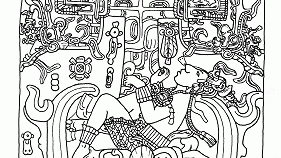Votan: Diffusionist Deity
Source: theorionzone.com
Confusionism In the Ivory Tower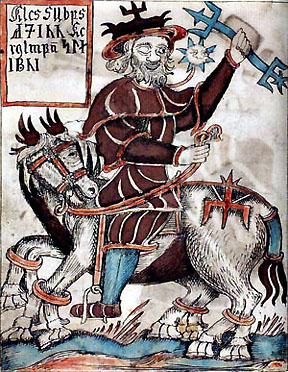 Cultural diffusionism continues to be anathema to academia. Put simply, diffusionism proposes that ancient people got around on foot or by boat a lot more than commonly assumed -- around the world, in fact. This theory posits that a free flow of trade goods and cultural motifs existed globally, perhaps as early as the Neolithic period.
Cultural diffusionism continues to be anathema to academia. Put simply, diffusionism proposes that ancient people got around on foot or by boat a lot more than commonly assumed -- around the world, in fact. This theory posits that a free flow of trade goods and cultural motifs existed globally, perhaps as early as the Neolithic period.During the 20th century anthropologists and archaeologists, many of them tenured or supported by universities, had suggested that the diffusionist theory, which prevailed in the last part of the previous century, is inherently racist. The theory, they said, implies that Caucasians had bestowed the benefits of civilization on the "darker" races in order to bring them toward the light.
Proposing an alternative isolationist theory, this Columbus-was-first crowd described a scenario of scattered, provincial tribes of Native Americans going it alone the best way they could on a sparsely populated continent. In our current age when racial equality is at least an ideal, the notion of a group of white, patriarchal benefactors influencing the "benighted" aboriginal cultures is indeed repugnant and retrograde -- if it were true.
But in some ways the isolationist theory is the racist one because it assumes that the native peoples of North and South America were not intelligent or skilled enough to accomplish long-distance travel either by land or sea -- other than the initial push from Siberia via the Bering Straits to Alaska and Canada.
On the contrary, the cultural interaction between continents, which began in pre-Christian times, was most likely a two-way street. In other words, Semitic, Egyptian, Hindu, and European cultures may have benefited as much or more from interaction with Native Americans than the other way around.
He Was Cosmo When Cosmo Wasn't Cool
In this essay I will generally discuss variations on the myth (read "primordial truths") of Votan and specifically explore the influence of the American Southwest's version of this culture hero on the Hopi Indians of Arizona, especially in regard to their pervasive and enduring snake cult. His presence in the South Pacific will be discussed, as well as his association with the Phoenicians of the Middle East and with the specific word mas.
I will furthermore show that Votan was not white, as he is commonly conceptualized, but instead was red, or at least a genetic mixture of the two. I will also talk about the northern version of Votan and, finally, describe his return vis-a-vis the figure of Quetzalcoatl.
One of the most clearly diffusionist legends comes to us from Mesoamerica. Votan, appearing as the bearded "god" clothed in a long, flowing robe, disembarked with his crew from a flotilla of ships upon the Gulf coast of Mexico.[1] He then ascended the Usumacinta River and established Na-Chan (or Na-Kan), the "City of Serpents," tentatively identified as Palenque in Chiapas, Mexico.
Votan is sometimes referred to as Lord Pacal, whose tomb was found in the Temple of the Inscriptions at Palenque. However, this famous Mayan ruler, who reigned between 615 and 683 AD, may have merely assumed the name of the much earlier deity.
The lid of Pacal's sarcophagus gained pop culture status, by the way, when in the late 60's Erich Von Daniken interpreted it as showing Pacal Votan seated at the control panel of an extraterrestrial spacecraft. We certainly live in strange times.
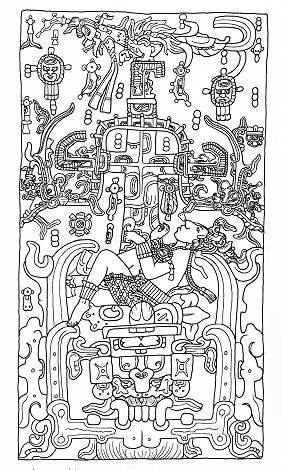
The Mayan king Pacal Votan
as depicted on his funerary slab
The actual name Votan comes from the Tzendal Maya of Chiapas. It literally means 'heart', and he was known as "the heart of the people." This deified human reputedly kept a record of the origin of the native races, which he gave to the guardians of a subterranean "Hall of Records" in Mesoamerica.[2] The whereabouts of this depository are still unknown. John Van Auken of the Edgar Cayce Foundation provides compelling evidence that it may be located at Piedras Negras in Guatemala, though this remains unconfirmed. [3]
Votan's mythological analogues include Kukulkan at Chichén Itzá, Gucumatz for the Quiché Maya, Itzamná in the Book of the Chilam Balam, Quetzalcoatl in the Aztec tradition, Viracocha in the Peruvian Andes [4], and Pahana among the Hopi.
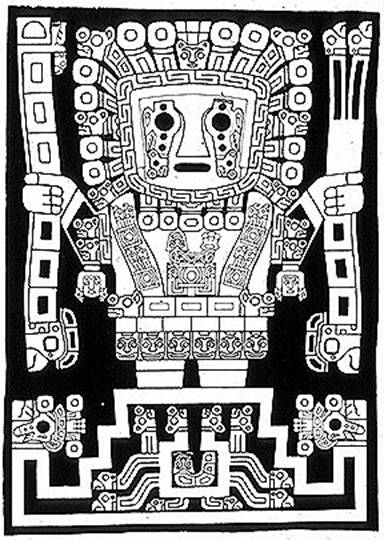
The pre-Incan god Viracocha from Peru
In the Mayan mythological, historical, medical, astrological, and esoteric text called Chilam Balam, for instance, we find the following prophetic lines: "Itzamná Kauil shall rise. Our lord comes, Itzá. Our elder brother comes, oh men of Tantun [Island of Cozumel]. Receive your guests, the bearded men, the men of the east, the bearers of the sign of God, lord."[5 ]
Votan was the archetypal bringer of civilization, bequeathing hieroglyphic writing, the codification of laws, the use of a complex Mesoamerican calendar, the cultivation of maize and cotton, sacrificial offerings of flowers and fruits rather than humans, and such diverse sciences as astronomy, metallurgy, ceramics, and medicine. It appears that he was, so to speak, a quintessential Renaissance man.
Across the Ocean Blue (Before Fourteen Hundred and Ninety-two)
For that time period, the cosmopolitan Votan clearly got around. But where did he come from? According to some authorities, he may have been a Phoenician from Carthage (modern-day Tunis). Author Adrian Gilbert, for instance, believes that the evidence for this rests in the friezes at Palenque. He says that the figures depicted there have large noses and their facial features generally look Semitic.[6]
Researcher Andrew Collins, on the other hand, thinks that Votan was probably a Hebrew, citing the Phoenicians' lack of serpent worship as well as their mercantile motives for navigation that superseded any interest in empire building.[7]
This theory is contradicted, however, by the fact that a "...snake's egg... [was] hung up in the temple of Hercules in Tyre, encircled by the Agathodaemon, or the good snake that gives rain."[8] This Phoencian version of the uroboros, or a snake swallowing its tail, is a symbol of eternity.
Another name for the port city of Tyre is Tsur, which in Hebrew means 'rock'. The Hopi word Tsur means 'wedged in a crack', and tsu means 'rattlesnake', which is also associated with rain. In addition, the Hopi tsu'ki refers to 'a hole inhabited by snakes'. The Hopi term tusyap, incidentally, denotes a 'flat rock'.
A winter solstice ceremony for the resurrection of the sun was held in the same Tyrian temple. This impressed the infamous Freemason Albert Pike:
"The temple of Hercules of Tyre was reported to have been built 2300 years before Herodotus [that is, about 2,800 years BCE]; and Hercules, whose Greek name has been sometimes supposed to be of Phoenician origin, in the sense of Circuitor, i.e. 'rover' and 'perambulator' of earth, as well as 'Hyperion' of the sky, was the patron and model of those famous navigators who spread altars from coast to coast through the Mediterranean, to the extremities of the West..." [9]
In Greek mythology Hyperion was the Titan (a giant) who fathered Helios (the sun), Selene (the moon) and Eos (the dawn). His name literally means 'above' (hyper-) + 'going' (ion). It is possible that Heracles (Hercules), whose altars most likely reached west to the New World, was a variation on the theme of Votan.
On one of four journeys back to his homeland named Valum-Chivim, the demigod Votan witnessed the construction of both the "house of God" (that is, King Solomon's Temple in Jerusalem, about 970 BC) and the Tower of Babel in Mesopotamia. Some authorities state that the latter was built about 1000 BC.
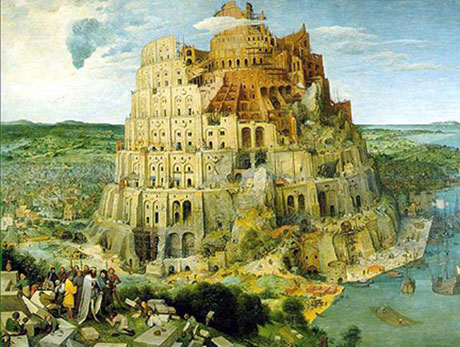
The Tower of Babel, 1563, Peter Brueghel
Pioneering diffusionist researcher Constance Irwin conversely provides a slightly later date: "Such was the Tower of Babel as rebuilt by Nabopolassar and his successor Nebuchadnezzar in the seventh and sixth centuries B.C. -- a date, by the way, which corresponds better with the possibility of four successful round-trip transatlantic voyages." [10]
Citing a history of Palenque written by an 18th century friar named Ramon de Ordoñez y Aguilar, Collins further remarks on one of these voyages made by Votan: "More curiously, on a second visit to the 'house of God' Votan 'was made to traverse an underground passage which ended at the root of the heavens.' Moreover, that this 'passage was nothing less than a snake hole, where he entered because he was a Son of Serpents'."[11]
I can think of no better description of the portal located on the floor of a Hopi structure called a kiva. This round or rectangular semi-subterranean prayer chamber found throughout the American Southwest is accessed via a ladder protruding from a hatchway in the ceiling. The hole in the floor, which is termed a sipapu, is the passageway to the underworld.
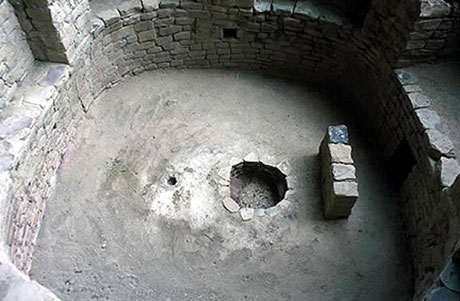
Ancient Hopi (Anasazi or Ancestral Puebloan) kiva.
The small hole to the left of the round fire pit is called the sipapu.
The model for this structure may have been imported from the Old World. The late epigrapher Barry Fell cites Herodotus' report of the Troglodytes of Libya, who once lived in semi-subterranean "apartments." Fell writes: "This arrangement, seen in the mountainous desert to the west of Tripoli, and extending into Tunisia, may be the origin of the circular kivas of the so-called pueblo towns of the southwest United States." [12]
On a macrocosmic scale, the sipapu in the Hopi kiva corresponds to a specific travertine dome known as the Sipapuni. It is found at the bottom of Grand Canyon near the spot where the Little Colorado River flows into the Colorado River. This supposedly is the entrance to an underground conduit leading to the previous Third World -- seat of the afterlife and the spiritual home of the katsinam (also spelled kachinas), or spirit messengers. [13] We are now at the end of the Fourth World, Hopi elders say.
Collins writes that Votan descended into the "snake hole" simply because he was descended from the lineage of serpents. It is significant that the biennial Snake Dance is still a major part of the Hopi ceremonial cycle in Arizona. If we can believe the stories of Votan's voyages around the globe, this sacred ritual may have come from elsewhere. (For more on this, consult my book The Orion Zone: Ancient Star Cities of the American Southwest -- available from: www.adventuresunlimitedpress.com.)
Irwin says that Chivim, the name of Votan's terrestrial origin, is derived from Chna, the English transliteration of the Greek word referring to Canaan, or the land of the Phoenicians. [14] The scholar Donald Mackenzie believes that Chivim refers to Tripoli, and that the name is a cognate of Hivam (or Givim), the Phoenician word for snake.
The Hivites are descendants of Heth, son of Canaan. (Genesis 10:15) [15] In this regard, the theosophist Madame Blavatsky comments: "The names Heva, Hivi or Hivite, and Levi, all signify a serpent; and it is a curious fact that the Hivites, or serpent tribe of Palestine, like the Levites or Ophites of Israel, were ministers to the temples." [16]
Collins additionally argues that Chivim is related to the Hebrew chevvah and the Arabic hawwa, both of which variously mean 'snake' and 'life'. More importantly, he stresses that these words refer to awwim, which is another name for the Nephilim. [17] These creatures were the "giants in the earth" from the Book of Genesis (6:4). They were, of course, the offspring of the so-called fallen angels and the "daughters of men."
A possible link exists between the Hopi katsinam mentioned above and these angelic "Watchers." Part of the Snake Dance ritual in the First Mesa village of Walpi is held in the kiva called Wikwa'lobi, or 'Place of the Watchers.' [18 ]
Nebuchadnezzar, the king who reconstructed the same Tower of Babel that Votan visited, received in a dream one of these Watchers, as the Book of Daniel (Chapter 4) records. In this context it is significant to note that the Hopi word tawa (phonetically similar to hawwa, the Arabic form of Chivim) means both 'to watch' and 'sun' or 'day'. The deified sun in his journey per diem across the sky is said to watch over the earth.
Furthermore, the Hopi word hawi means 'to come down', perhaps from the sky, and the word mongwi mean 'chief'. Put these together and you have the sense of "chief-comes-down-from-the-sky"-- á la the arrival of the Watchers. It is perhaps more than a coincidence, then, that the megalithic structure on the South Pacific island of Tongatapu is called the Ha'amonga of Maui. This is not as much a digression as it sounds.
Tales of the South Pacific
On the island of Tonga the massive trilithon, as it is called, is constructed of two upright, rectangular pillars rising fifteen feet and weighing fifty tons each. A rectangular lintel eighteen feet long and weighing approximately nine tons was placed on top. Built perhaps as early as 1500 BC, this structure probably served a purpose similar to that of Stonehenge -- as a solar, lunar, and stellar observatory. In fact, notches in the stones of the trilithon mark the summer and winter solstices.[19]
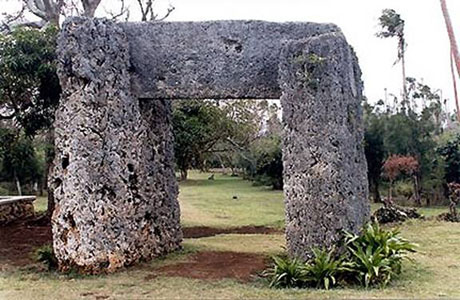
The Ha'amonga of Maui, the trilithon on Tonga
Barry Fell opined that legends of Maui were based on an actual maritime explorer of Oceania, who sailed east from the Indian Ocean across the Pacific in 232 BC. "The word mawi in Egyptian means a guide or navigator, but it also sounds very like the Polynesian name Maui. In Polynesian legend Maui was a great sailor who, in the figurative speech of Polynesian tradition, was said to have 'fished up new lands' from the sea... -- a poetic way of recording his discovery of lands hidden beneath the horizon." [20 ]
The Hopi word maawi, by the way, means 'to pick beans or fruit'. This suggests pulling up food from the soil in the same manner that Maui metaphorically pulled up islands from the bottom of the sea.
The key calendrical positions found on the trilithon are also used by the Hopi Water Clan. Its members are the traditional sun-watchers, keeping track of the solstice and equinox points on the horizon. The clan plays a large part in determining the agricultural calendar -- sowing, cultivating, harvesting, etc. A calendar is absolutely essential for survival in their harsh climate.
Did the Hopi once use these same skills to navigate across vast stretches of ocean? This is perhaps the case, since another name for the Water Clan is the Houseboat Clan. Oddly enough, one Hopi legend describes them escaping a great deluge on bamboo rafts across the Pacific Ocean. They sailed eastward from one "steppingstone" (island) to another until they eventually landed on the western shores of Mexico.
The Water Clan then traveled north, either on foot or by boat, to arrive at the Baja Peninsula and the mouth of the Colorado River. After poling upstream they came to Grand Canyon. This served as their "Place of Emergence" (or Sipapuni -- see reference above) from which they spread out upon the Colorado Plateau where they still live in pueblo villages made of stone. So, apparently these denizens of the desert were once great mariners -- or at least the members of the Water Clan were.
This clan possesses the knowledge that a culture hero such as Votan may have once shared. He was also known to have the ability to measure the earth [21], thus engaging in what best-selling author Graham Hancock calls "geodetic prospecting."
In his discussion of Rapa Nui (Easter Island) and other sites, Hancock describes the function of a worldwide grid system used by figures such as Votan: "What we are suggesting therefore is that Easter Island might originally have been settled in order to serve as a sort of geodetic beacon, or marker -- fulfilling some as yet unguessed at function in an ancient global system of sky-ground co-ordinates that linked many so-called 'world navels'."[22]
The natives of Rapa Nui call their original homeland Hiva, an island that long ago sunk beneath the sea like the legendary continent of -- at the risk of using the 'A' word -- Atlantis. We remember, of course, that the Phoenician name for snake is Hivam. We also recall that the Hopi performed many of their sacred ceremonies in a kiva. In the Rapa Nui language, kiva means 'to keep a secret'. http://www.rongorongo.org/vanaga/k2.html On Mauke (one of the Cook Islands), the name O Kiva means 'ocean'.
And what can we make of the following? Easter Island is located on the same longitude as the final territory of the Hopi. Is this meridian alignment merely a coincidence? Or is it synchronicity -- what psychologist C. G. Jung calls a "meaningful coincidence"?
Regardless of whether Votan was Phoenician, Hebrew, or of some other ethnic origin, he must indeed have been a potent force for worldwide cultural transformation.
The Red Man and the Sea
The Hopi Water Clan supposedly resided for a time far to the southeast of the Arizona desert in a mythical city called Palatkwapi. Southeast is also the general direction where the Maya live. It may be significant in this context that Palenque's stucco walls were once painted a brilliant crimson.
On the other hand, the Hopi name Palatkwapi, which actually means "City of the Red People" or simply "Red City," probably refers to its inhabitants rather than to building materials or landscape. Diffusionist proponent James Bailey writes in this regard: "The name Phoenician means Red Men. The name Red Sea then covered what is now called the Indian Ocean as well as what we today call the Red Sea and meant the Sea of the Red Men." [23 ]Herodotus (in The History, VII, 89) was the first to recognize the Red Sea area as the origin of the Phoenicians.
In his subsequent book Bailey takes this even further: "Amerindians are brown-skinned. The Greeks used the term Phoenician, meaning redmen, for the different clans of Western Semites. So the term Red Indian may have derived from this long period of Phoenician government across large parts of America." [24]
The renowned Atlantean scholar Ignatius Donnelly adds: "The ancient Egyptians were red men. They recognized four races of men -- the red, yellow, black, and white men. They themselves belonged to the 'Rot,' or red men..." [25] Hence, we now have another culture from which Votan may have originated.
Back in the American Southwest, one Hopi legend describes the chief of the Water Clan dividing pieces cut from the neck of Palulukang, the horned water serpent, in order to give to all those who once lived at Palatkwapi, City of the Red Men. This frightening creature inhabits bodies of water such as springs or lakes and has the power to bring rain. [26] Again the snake raises its head from this dizzying whirlpool of cultures.
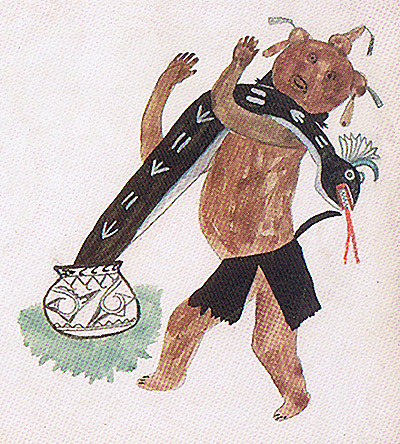
The Hopi water serpent Palulukang rising from ceramic pot,
as it struggles with a "Mudhead" ogre or clown.
(Drawing from Jesse Walter Fewes,
Twenty-first Annual Report of the Bureau of American Ethnology)
To make matters even more confusing, the Hopi author Albert Yava makes the following politically incorrect statement: "One thing you hear from the Patki [Water Clan] people is that in ancient times they were white, not Indian color. They say, 'My ancestors had white skins, but because of evil things that happened, we lost all that.' They also say, 'The Patki people are the ones who are supposed to teach the Hopis good moral values, how to lead good lives.'" [27].
This might be evidence of the pre-Columbian merging of two peoples -- the Amerindian and the Semitic/Hamitic. In the case of either the Phoenicians or the Egyptians, the self-designated racial classification of "red" may indicate that this process had already occurred.
I should furthermore point out that Votan and his men selected mates from the native population they encountered. It is almost as if integration and miscegenation were a spiritual imperative.
Perhaps for this reason we see a similarity between the name of the Patki (or Water) Clan and the Sanskrit word for Phoenician: Pani or Panch -- especially if we attribute a hard "ch" sound to the latter term. The Tibetan usage of this term is especially relevant. The Panchen Lama, second in spiritual importance to the Dalai Lama, is derived from the Chinese word banchán. This word is a transliteration of the Sanskrit pandita, or pundit, literally a 'learned man'. We must remember that the Phoenicians were the ones who invented the alphabet.
At this point a number of questions arises: Did a "Red Man" or "red men" actually have something to do with the migration from the previous Hopi Third World (or era now conceptualized as being spatially subterranean) into the current Fourth World (or earth plane)? Did the Hopi Mesas of Arizona become the New World Canaan, to which this tribe was ultimately led? Was the Old World seen as the antipodal underworld?
In his insightful research, comparative linguistics scholar Gene D. Matlock describes a possible scenario:
"Maasawa [Masau'u] agreed to aid and finance the departure of the Hopi. To lead them out of Muski [Maski, the underworld], he contracted the services of what the Hopis call 'white men,' known as Bahanna [Pahana]. Then, their Wind God, Yaponche [Yopontsa], blew them across a great lake to the Promised Land. In Sanskrit, Vahana means 'mover, transporter; ship; vessel, boat.' Panch was a Sanskrit name for Pani or Phoenician." [28 ]
The Hopi deity of death and the underworld is named Masau'u (or numerous other orthographic variations). He is also the lord of the earth. If some sort of long-distance influence on the Hopi in general and the Water Clan in particular did not exist, why else would we find Massawa located on the eastern shores of Africa? This is, in fact, the name of a major port on the Red Sea! It appears that Masau'u, together with Pahana, assisted at least some of the Hopi in their ancient journey to the New World.
More on the Massing of Mas
The following are Sanskrit variations of mas:
mAs -- 'flesh, meat'
mAs -- 'moon, month'
maS -- 'to hurt, to injure'
mas -- 'to measure, to mete'
In Hopi mas (or maas) means 'gray', as in putrefied flesh, or 'ghostly'. Their god Masau'u is the terrestrial equivalent of Orion, the Hunter. Like Osiris, he metes out punishment in the underworld. On the positive side, Masau'u, with his planting stick and sack of seeds, taught the Hopi how to grow corn. This is also part of the curriculum vitae of Votan.
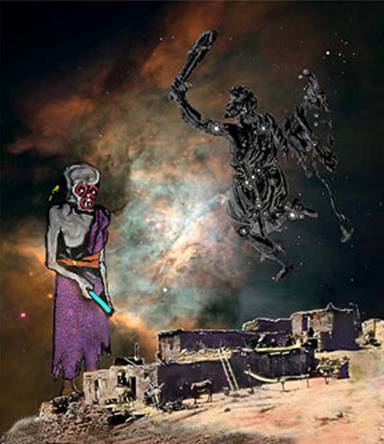
Collage of the death-and-earth god Masau'u, pointing his staff
at the Hopi village of Oraibi, Arizona, with Orion overhead
It is interesting to note that the Hopi word puukya means 'flesh', 'skin', or 'animal hide', while the related word p“ikya means 'immature ear of corn'. In addition, agriculture naturally involves lunar cycles -- one of the Sanskrit meanings of mas.
The English word mass, which refers to common physical matter, is derived from the Greek word máza, literally 'barley cake'. The word maize comes from the Taino word mahis, which means 'source of life'. The Taino, by the way, were the Indians that Columbus encountered on the Caribbean island of Hispaniola.
In the Bible one of the sons of Ishmael was named Massa. The term Masani, which literally means 'burden', refers to an Arab tribe near the Persian Gulf. (Did its members carry their burden to a new land?) The Hebrew word Masorah means 'tradition'. In Ezekiel 20:37, it is used to denote 'fetter' or 'bond'. In addition, Massah was the place at Horeb where Moses struck a certain rock with his staff and water miraculously came out. (Exodus 17:7. Also in this same book of the Bible, we see both Moses and Aaron throwing down their staffs, which then turn into serpents.)
The official Website of the Theosophical Society ( www.theosociety.org) contains the following definition of the word Masben: "The sun in putrefaction, used in modern Freemasonry with a direct reference to their 'word at low breath.'" The disturbing concept of putrefying flesh is very much a part of the Hopi god's purview.
The Phoenician term mastruca refers to the coarse skins of wild animals worn by the people of Carthage and Sardinia, both Phoenician colonies. [29] This word may be connected with the first Sanskrit definition of mas given above.
In Sudan at a place called Masawwarat es-Sufra, an archaic temple structure complete with colonnades and porticos was built probably in the late Ptolemaic dynasty (305 - 30 BC). It surprisingly contained carvings of serpents. Fifteen miles to the south on route to the Blue Nile was located a temple complex called Naga (which is the name of the serpent worshippers of India). This city featured a characteristically Egyptian pylon. [30]
The Egyptian word maas meant 'to slay, to kill' [31], thus reinforcing the connection Masau'u has with death. The ancient Egyptians were mas-ters of word play, so the word mas (m's) also had the meanings of 'to bring forth', 'to pass on or into', [32] or perhaps even 'to give birth'. It additionally carried the sense of 'to fashion a statue' (containing the ka, or spirit, of the person represented). [33]
The distribution of place-names containing the syllable mas ranges from Ethiopia (land of the Masai Mara tribe) up the Red Sea coast into Egypt and even farther north into Iraq.
South to North:
- Masaka, on the western shore of Lake Victoria.
- Ras (Cape) Maskan, south of Djibouti.
- Mawshij, on the western coast of Yemen on the Red Sea.
- Massawa, a major port city of Eritrea what first keyed me into this region.
vis-a-vis the Hopi god Masau'u. [34] - Masqat, capitol of Oman, as well as the nearby Island of Masüirah.
- Mastabah (like the flat-topped burial pyramid?), on the coast not far from
Mecca, as well as Masturah, a little over 100 miles to the north. - Mashabih Island, off the coast of Saudi Arabia.
- Masak el Sharib and Masak el Rakhiyat in Egypt, west of the Strait of Gubal leading into the Gulf of Suez.
- Masara, on the Nile about a dozen miles south of Armana, where in the mid-fourteenth century BC Akhenaten built his city named Akhetaten.
- Al Mawsil (or Mosul, the northern Iraqi city).
This last site is, of course, located in ancient land of Sumer -- tragically embattled to this day.
In the Sumerian Epic of Gilgamesh, we find a reference to the "land of Mas" (or Mashu). Variously described as giants, spirits, demons, or fierce gods, a pair of "scorpion men" guards the entrance to the underworld.
"Mashu is the name of the mountains. At last he reached them,
Where every day they keep watch over the rising and setting
of Shamash, the sun god.
To the zenith of heaven rise their summits, and downward
Deep into hell reach their breasts. At their portals stand sentries:
Scorpion men, awful in terror -- their very glance is death, and tremendous
Is their magnificence, shaking the hills. They are the wardens of Shamash,
Both at his rising and setting. No sooner did Gilgamish see them
Than from alarm and dismay was his face struck with pallor.
Senseless, he groveled before them.
Then the scorpion man to his wife spoke:
'He who comes to us -- his body is the flesh of the gods'.
But his wife answered: 'Only two parts of him are god-like;
A third of him is human'." [35]
Is the Hopi underworld, which is named Maski, the same as Mashu? The mountains of Mashu apparently reach from the heavens deep into hell. The related Sumerian word MASKU means 'skin' or 'hide'. This semantically corresponds to the skin of the Hopi god Masau'u and his deathly gray pallor. (MASKU may also be where the English word 'massage' comes from. Also, the Arabic massa means 'to handle'.)
In this context it is significant that Gilgamesh's "flesh" is two-thirds god and one-third human. The Sumerian demigod may indeed be a dead ringer for Votan himself.
In addition, the Sumerian phrase Maskim Xul refers to Evil Fiend, or Ambusher. Various legends attribute this role to the Hopi deity as well.
The Land of Mas was located in the Valley of EDIN. The Sumerian MASALU means 'to make equal'. Was Eden that paradise far in our shamanic past before the biblical Fall, when humans and animals could speak the same language and were equal? Of course, the serpent changed all that (in Chapter 3 of Genesis). We recall that the Tigris and Euphrates in present-day Iraq were two rivers in Eden.
Members of the Yaresan religious sect of southern Kurdistan believe that the Masya was the first man, Adam, while Masyanag was the name of Eve. [36] Notice the syllable -nag, or 'snake', in her name.
The Armenians refer to Mount Ararat, where Noah's ark reputedly landed, as Masis. Some believe that the Garden of Eden was located somewhere near Armenia.
On our tour of place-names derived from the syllable mas (the root of the name of the Hopi god Masau'u), let's not forget Masada in Judea. This fortress atop a large mesa overlooking the Dead Sea was where the revolutionary Jewish zealots called Sicarii made their last stand in the first century AD. They were waiting there for the Messiah, or in Hebrew, the Mashiah.
Lastly, the Arabic word masr refers to either Cairo or all of Egypt, which brings us back to the "Red Men" that inhabited that land.
What exactly does "red" mean in this respect? A red place? The major city of Atlantis was Poseidon -- traditionally known as the "Red City."
Red skin? We recall the Hopi site of Palatkwapi, or "City of the Red People."
Red hair? Members of the Hopi Fire Clan who lived with the Snake Clan in the northern Arizona cliff dwelling of Betatakin (now part of Navajo National Monument) were known as "redheads." In 1911 inside a cave near Lovelock, Nevada, guano miners found mummified giants with red hair. (Didn't the "giants in the earth," a.k.a. the Nephilim, also have red hair?) Some of the giant Easter Island statues called Moai have red topknots carved from blood-red scoria, considered to be a sacred sign of the high priesthood.
Red metal? (Copper, of course, defined the Bronze Age.) The Hopi word voton means 'coin'.
Red blood? Was Votan (or the Hopi version Pahana) red or white? The Hopi word pala means 'red', while pahan means 'white' (Anglo). In all probability he was both.
Nordic Trek
One god of Norse mythology shares many of the same attributes with Votan. Odin was the deity of prophecy, magic, and poetry. He invented the runic alphabet and sacrificed his right eye in a sacred spring to gain otherworldly wisdom. Perhaps he even strove to be, as Matthew 10:16 says, "wise as serpents."
He also hung on the World Tree named Ygddrasil, (literally, the 'horse of Odin'), for nine days and nights, wounding himself with his own spear -- thus suggesting some sort of shamanic ritual. This is described in the "Hava Maal" of The Poetic Edda from Iceland. [37] Hava Maal literally means "Sublime Discourse," but notice the similarity to the Hebrew word heva, which (as previously stated) means 'snake'. An underworld dragon named Níohoggr (or Nidhogg) gnawed at the roots of this cosmic ash tree. The dragon is, of course, a variation of the serpent.
Odin would also welcome slain warriors into Valhalla, the hall of the afterlife. Frequently carrying a staff like Moses, this bearded individual was furthermore associated with wandering and the hunt.
By the way, the Teutonic version of Odin's name is Wotan.
He rode an eight-legged steed named Sleipnir, which literally means 'smooth' or 'gliding' and is related to the English word 'slippery'. Indeed, Odin is also the master of cunning, deceit, and trickery. His miraculous mount could bear him swiftly across the sea or the air, but it also had the ability to journey to the land of the dead. In a word, he was mercurial.
It has been suggested that Slepnir's eight legs metaphorically represent those of four pallbearers. They may also be a kenning that signifies four pairs of oars on a Viking ship. A kenning is a type of circumlocution common in Old Norse and Old English poetry. Then again, Odin's horse just might be a means of circum-location, or circumnavigation.
Author Philip Gardiner explains kenning (also spelled "kynning") as an esoteric process: "This kynning is, of course, the origin of cunning, and originates from words etymologically associated with the wise serpent (can is serpent)." [38]
Arachnids (including "scorpion men" and spiders) are the only creatures in nature with eight legs. In this context I should mention a certain Spider Woman from Hopi legend. Revered as a guardian, Kotyangwúti helped their culture hero named Tiyo in his journey across the ocean to the island of the Snake People (Nagas?) From these beings he learned the aforementioned Snake Dance ceremony, which he brought back to Arizona.
One 18th century Icelandic depiction of Odin astride his usual mode of travel shows the god holding a double trident in his left hand. This is similar to both the staff of Jupiter and the staff of Adad -- the latter being the Babylonian god of thunder and lightning. This is comparable to the Hindu vajra that either Indra or Shiva wields. (Was this also like the staff-cum-serpent of Moses?) If one removes the barbs on Odin's staff, it becomes the zodiacal symbol for Pisces. The trident is, of course, associated with the sea god Poseidon, who was the supreme monarch of Atlantis.
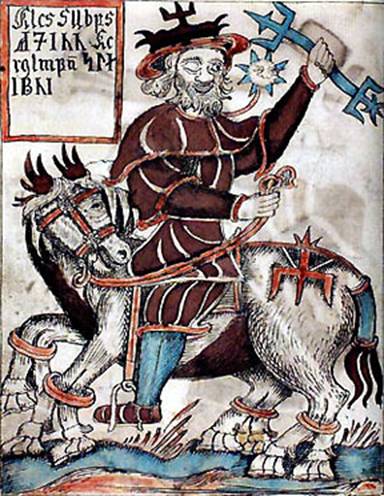
One-eye Odin rides his horse Sleipnir
(from an 18th century Icelandic manuscript)
Ultimately some sort of euhemeristic transformation probably took place in regard to Odin/Wotan/Votan, whereby an historic figure or group gradually gained the status of a god. If this were the case, ancient travel between continents apparently was the rule, not the exception. As we have seen, traces of global interaction still exist in both the tropical South Pacific and the arid American Southwest but especially in southern Mexico.
Return of the Snake-eye
"In the days of Quetzalcoatl there was abundance of everything necessary for subsistence. The maize was plentiful, the calabashes were as thick as one's arm, and cotton grew in all colours without having to be dyed. A variety of birds of rich plumage filled the air with their songs, and gold, silver, and precious stones were abundant. In the reign of Quetzalcoatl there was peace and plenty for all men." [39 ]
It sounds like paradise. But, as the cliché goes, all good things must come to an end, including the sovereignty of Votan (or, in his Aztec incarnation, Quetzalcoatl). Some believe that necromancers or evil priests overturned his original precepts of enlightened non-violence and instituted human sacrifice. One myth describes the god Tezcatlipoca ("Fiery Mirror") plying Quetzalcoatl with the intoxicating drink pulque, thereby causing the latter to fall into dissolution and moral decay.
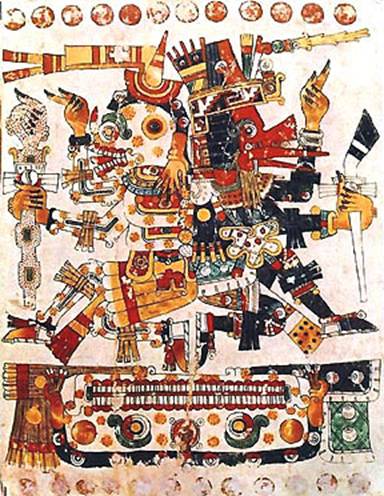
The Aztec god Quetzalcoatl -- note red face or mask.
The feathered serpent finally abdicated his authority in Mexico and sailed toward the rising sun on a raft of snakes. In another version he cast himself upon a funeral pyre, after which the eponymous quetzal bird with its brilliant plumage rose phoenix-like from the ashes. Quetzalcoatl's heart then ascended into the sky to become the Morning Star (Venus).
Before departing toward the east, however, he had promised to return one day for the purpose of redeeming the land and its people from the trials and suffering they were destined to endure.
In the early 16th century Hernando Cortés conquered -- almost too easily -- Moctezuma and his Aztec subjects at Tenochtitlán (now Mexico City). This rapid capitulation was due in part to the native leader's belief that the Spaniard was fulfilling the prophecy of the ancient god's return.
Whether we are talking about the Aztecan Quetzalcoatl or the Mayan Votan, the disastrous result was the same: magnificent cities with their soaring temples and pyramids were left in smoking ruins, while sacred codices with their accumulated knowledge were callously consigned to the flames or lost in the jungles.
It is interesting to note that one of the meanings of the Spanish word votan is 'a religious vow'. In this case the vow to convert all inhabitants of the New World to the Catholic faith resulted in the almost complete destruction of a fiercely brilliant aboriginal culture that had flowered for millennia.
Apocalypse Tao
The facts presented in this essay join the plethora of evidence for pre-Columbian intercultural exchange, ultimately producing a cumulative effect. An increasing array of distinct artifacts and customs found on separate continents seems to have mutual elements. Their sheer number and diversity belie any notion of independent invention in isolation. The only plausible explanation is that extensive maritime travel and trade were the norm prior to the Christian era.
Either the discovery of new methods of DNA testing or the refinement of current ones will soon make its results more conclusive. Scientists will then be able to find genetic evidence that proves "deities" such as Votan were diffused or dispersed across the globe beginning perhaps as early as the Upper Paleolithic. Very recent findings point toward this:
"The DNA data ... suggest a lot more to-ing and fro-ing than has been suspected of populations during the past 30,000 years in Northeast Asia and North America. The analysis of the dataset shows that after the initial peopling of Beringia [Bering land bridge], there were a series of back migrations to Northeast Asia as well as forward migrations to the Americas from Beringia, thus 'more recent bi-directional gene flow between Siberia and the North American Arctic.'" [40]
In light of this and other scientific data, the ivory tower isolationists are becoming increasingly tedious. Their tenuous arguments probably have more to do with professional tenure than anything else.
But these petty academic skirmishes pale in comparison to what increasingly looks like an impending Endgame. The Hopi living on their isolated mesas of Arizona continue to perform sacred rituals in a desperate attempt to keep the whole world in balance. This is the basic reason that they maintain their ceremonial cycle: not for themselves but for Mother Earth.
Despite their heroic efforts, though, they are losing the battle. Because of the onslaught of modern society upon their traditional life-ways, many of the ancient ceremonies are dying out. Fewer and fewer youth are learning the Hopi language. It has been remarked that the Maya are the guardians of time, while the Hopi are the guardians of space (namely the Earth). As 2012 approaches, the Hopi are less and less able to be of service to the planet through their rituals. As a result, the world is increasingly out of balance. The only thing they can do now is to wait for Pahana's return.
CNN recently broadcast a series about environmental degradation called "Planet In Peril." Daily reports of the deleterious effects of "climate change" (hurricanes, coastal flooding, record rainfall and snowfall levels, tsunamis, droughts, forest fires, Arctic/Antarctic ocean warming, etc.) all produce a siege mentality in those sensitive to the increasingly morbid condition of Gaia. Who among us -- except chronic skeptics or those with their heads in the sand -- would deny that we are facing a global crisis, a live-or-die situation of monumental proportions?
If we combine this with the contemporary reality of nuclear proliferation, terrorist suicide bombings, oil shortages, geopolitical instability, Developing World mass poverty, refugee camps, famine, and epidemics, the very fabric of our existence seems to be unraveling right before our eyes. Has Death finally won the game of chess? Is the seventh seal about to be opened?
Even in an era of nanotechnology, robotics, genetic manipulation, cell phones, and cyberspace, we still await the return of some primary archetypal force that speaks to all religions, ethnicities, and philosophies. The ancient Chinese called it the Tao, or the all-encompassing Way. If our grandest dreams indeed prove real, then this purveyor of peace and enlightenment could ultimately save us from annihilation.
In the chaos -- and "confusionism" -- of these times, the catalyst for our new beginning may be the legendary Votan, who comes back again to vanquish the legions of evil. We can only hope.
Endnotes
1. The presence of non-Amerindian, bearded sculptures in such diverse Mesoamerican ancient cities as La Venta, Chichén Itzá, Monte Alban, and other sites too numerous to mention is well documented.
2. T. J. O'Brien, Fair Gods and Feathered Serpents: A Search for Ancient America's Bearded White God (Bountiful, Utah: Horizon Publishers, 1997), pp. 64-65.
3. John Van Auken and Lora Little, The Lost Hall of Records: Edgar Cayce's Forgotten Record of the Human History in the Ancient Yucatan (Memphis, Tennessee: Eagle Wing Books, Inc., 2000).
4. Graham Hancock, Fingerprints of the Gods: The Evidence of Earth's Lost Civilization (New York: Crown Trade Paperbacks, 1995), p. 103-104.
5. Book of the Chilam Balam, XXIV, translated by Ralph L. Roys, 1933, at www.sacred-texts.com
6. Adrian Gilbert, Maurice M Cotterell, The Mayan Prophecies: Unlocking the Secrets of a Lost Civilization (Shaftesbury, Dorset: Element Books Limited, 1996, 1995), p. 202.
7. Andrew Collins, introduction by David Rohl, Gateway to Atlantis (New York: Graf Publishers, Inc., 2000), p. 340.
8. J. F. Hewitt, The Ruling Races of Prehistoric Times In India, South-western Asia and Southern Europe (Westminster, England: Archibald Constable and Company, 1894), p. 249. (Digitalized at http://books.google.com/.)
9. Albert Pike, Morals and Dogma (Charleston, South Carolina: The Supreme Council of the Southern Jurisdiction, 1928, 1906, 1871), pp. 78-79, p. 591.
10. Constance Irwin, Fair Gods and Stone Faces: Ancient Seafarers and the New World's Most Intriguing Riddle (New York: St. Martin's Press, 1963), p. 102.
11. Collins, Gateway to Atlantis, p. 336.
12. Barry Fell, Saga America (New York: Times Books, 1980), p. 245.
13. Hopi katsinam (also spelled kachinas) are masked figures that can represent any object or energy in the universe. Like angels, they are benevolent intermediaries between the divine realm and the human realm. Every spring and early summer katsina dances are held in the plazas of ancient Hopi villages. The dancers imitate these spirit messengers and in the process actually become them.
14. Irwin, Fair Gods and Stone Faces, pp. 100-101.
15. Donald A. Mackenzie. Myths of Pre-Columbian America (Mineola, New York: Dover Publications, Inc., 1996, 1923), p. 266.
16. H.P. Blavatsky, Isis Unveiled: A Master-Key to the Mysteries of Ancient and Modern Science and Theology, Vol. II (Pasadena, California: Theosophical University Press, 1950), footnote p. 481.
17. Collins, Gateway to Atlantis, pp. 341-342.
18. Victor Mindeleff, A Study of Pueblo Architecture in Tusayan and Cibola (Washington: Smithsonian Institution Press, 1989, reprint 1891), p. 136.
19. David Hatcher Childress, Ancient Tonga & the Lost City of Mu'a (Stelle, Illinois: Adventures Unlimited Press, 1996), pp. 26-33.
20. Fell, Saga America, p. 262-3, p. 294.
21. James Bailey, The God-King & the Titans: The New World Ascendancy in Ancient Times (New York: St. Martin's Press, 1973), p. 206.
22. Graham Hancock and Santha Faiia, Heaven's Mirror: Quest For the Lost Civilization (New York: Crown Publishers, Inc. 1998), p. 224, p. 254.
23. Bailey, The God-Kings & the Titans, pp. 245-246.
24. Jim Bailey, Sailing To Paradise: The Discovery of the Americas by 7000 BC (New York: Simon & Schuster, 1994), p. 57.
25. Ignatius Donnelly, Atlantis: The Antediluvian World (New York: Dover Publications, Inc., 1976, reprint 1882), p. 194.
26. Harold Courlander, The Fourth World of the Hopis: the Epic Story of the Hopi Indians As Preserved In Their Legends and Traditions (Albuquerque: University of New Mexico Press, 1991, 1971), p. 77.
27. Albert Yava, Big Snow Falling: A Tewa-Hopi Indian's Life and Times and the History and Traditions of His People (Albuquerque: University of New Mexico Press, 1982, 1978), p. 62.
28. Gene D. Matlock, "Is the Hopi Deity Kokopeli an Ancient Hindu God?", ViewZone, at http://www.viewzone.com/kokopeli.html http://books.google.com/.)
29. Anthony Rich, A Dictionary of Roman and Greek Antiquities (London: Longmans, Green, and Co, 1893), p. 413. (Digitalized at http://books.google.com/.)
30. P. D. Scott-Moncrieff, M.A., "The Ruined Sites at Masawwarat es-Sufra and Naga," Proceedings of the Society of Biblical Archaeology, Vol. XXX, Thirty-eighth Session, Jan-Dec. 1908, London), p. 196. (Digitalized at http://books.google.com/.)
31. E. A. Wallis Budge, An Egyptian Hieroglyphic Dictionary, Vol. I (New York: Dover Publications, Inc., 1978, 1920), p. 270.
32. Budge, An Egyptian Hieroglyphic Dictionary, Vol. I, p. 286.
33. W. J. Perry, The Children of the Sun: A Study of the Egyptian Settlement of the Pacific (Kempton, Illinois: Adventures Unlimited Press, 2004, 1923), p. 434.
34. John Philip Cohane, The Key (New York: Schocken Books, 1976, 1969), pp. 114-115.
35. Adapted from The Epic of Gilgamish, Ninth Tablet, translated by R. Campbell Thompson, 1928, at www.sacred-texts.com
36. Andrew Collins, From the Ashes of Angels: the Forbidden Legacy of a Fallen Race (Rochester, Vermont: Bear & Company, 2001, 1996), p. 196.
37. Henry Adams Bellows, The Poetic Edda (New York: The American-Scandinavian Foundation, 1968), p. 60.
38. Philip Gardiner, The Ark, The Shroud, and Mary: The Untold Truths About the Relics of the Bible (Franklin Lakes, New Jersey: New Page Books, 2007), p. 160.
39. Lewis Spence, The Myths of Mexico and Peru, 1913, at www.sacred-texts.com
40. "New Ideas About Human Migration From Asia To Americas," Science Daily, October 25, 2007, at http://www.sciencedaily.com/releases/2007/10/071025160653.htm.
Gary A. David is author of The Orion Zone: Ancient Star Cities of the American Southwest, available from www.adventuresunlimitedpress.com. His book Eye of the Phoenix: Mysterious Visions and Secrets of the American Southwest will be published in early 2008. He and his family have lived in rural northern Arizona, USA, for thirteen years.
Article received from Gary A. David
